
common pests of columbine.
Columbines are generally low-maintenance (if short-lived) plants with few problems in home gardens. But there are two types of insect pests that can be locally common that cause conspicuous damage to the plants, especially on hybrid columbines (Aquilegia × hybrida): columbine leafminers and columbine sawfly. Fortunately the damage usually only affects the plant’s appearance and generally doesn’t impact the plant’s health or survival. If either of these pests become too problematic, a better choice is to replace them with the native Aquilegia canadensis that is not affected nearly as much.
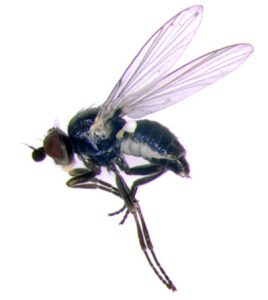
Photo © 2011 by MJ Hatfield,
from http://bugguide.net/node/
view/597738
Columbine leafminers are small, dark colored flies native to North America that gardeners rarely notice. The species Phytomyza aquilegivora is the most common one that commonly occurs in the Midwest, making distinctive serpentine trails in the leaves. P. aquilegiana, which produces blotch mines, occurs in eastern North America, and P. columbinae is a western species that creates linear mines. The female fly lays its eggs singly on the leaves in spring about the same time the plants are starting to flower. The larvae (maggots) then tunnel into the leaf, feeding on the tissue between the upper and lower leaf surfaces.
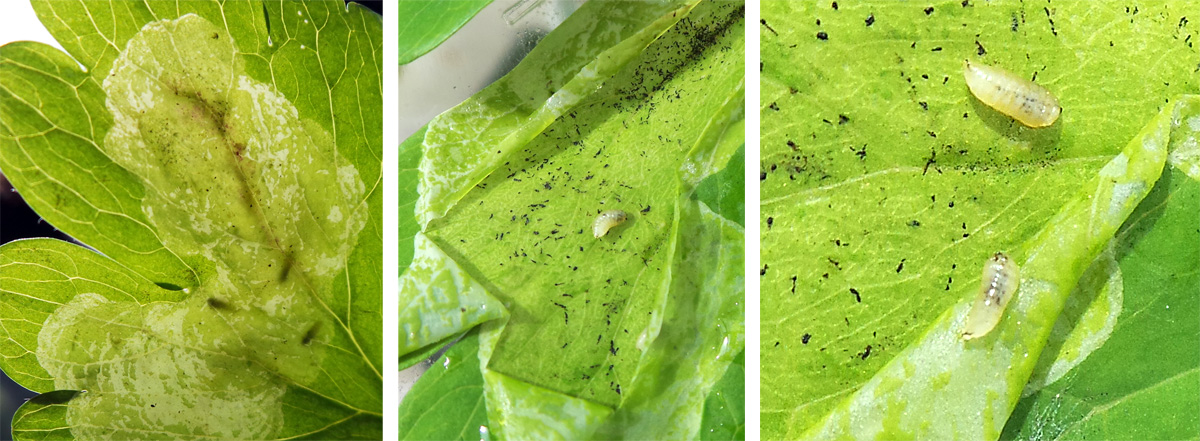
the small white maggots (R).
As they eat their way through the tissue, they produce meandering tunnels that grow wider as the insects develop. This feeding shows as a squiggly white line or trail (or blotch) on the outside of the leaf. There can be more than one larva per leaf.
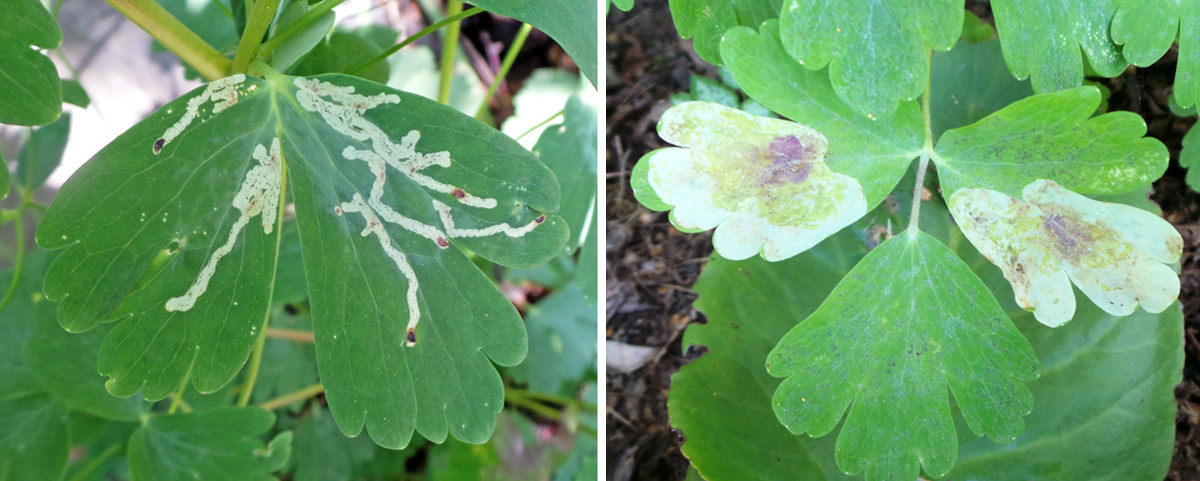
blotch mines of P. aquilegiana (R).
Once the larva has completed its development it tunnels out of the leaf and cuts a crescent shaped hole in the leaf to pupate hanging on the underside of the leaf in a small yellowish to dark brown, shiny puparium. After a few weeks another generation of adults emerge. There can be up to 3 generations per year, with the last generation of maggots dropping to the ground, to burrow in and overwinter in the soil as pupae.
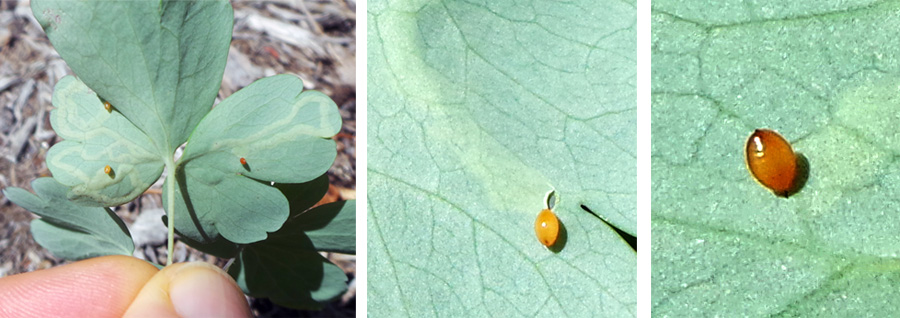
hole to emerge (C) to pupate in a dark brown puparium (R).

punctures on columbine leaf.
Because the damage is usually only cosmetic, chemical controls are generally not recommended. Unless the infestation is really heavy, the mines can be ignored, or the affected leaves can be picked off and destroyed (as early as possible, before the larvae pupate, to reduce the population in the next generation). There are also many hymenopteran parasitoids that will kill columbine leafminers, although they will not prevent leaf damage, since the parasitized larvae still mine the leaves before they are killed. If insecticides need to be used, treatments should be applied when the adults first appear. The adult flies make punctures in the foliage with their ovipositors in order to drink plant fluids, and these small marks are a good indication of the activity of these insects; insecticide applications should be made as soon as they appear to kill both the adults and the newly hatched larvae (but these materials likely will kill beneficial insects, too). Once the maggots are inside the leaf insecticidal sprays will not be able to reach them.
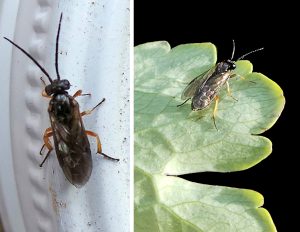

amid pea gravel (RC) and a single brown cocoon (R).
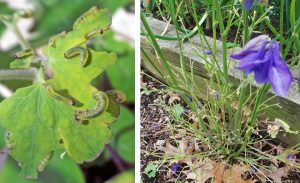
damage can be dramatic (R).
The larvae are only active in late spring, usually from April to June. If numerous, they can devour all the leaves, leaving only the stripped stems and flowers. Severe infestations can kill a plant but this is rare. Their feeding damage is primarily cosmetic and even columbines that are completely defoliated will recover. Unless stressed by other factors, within a few weeks it will put out another flush of leaves.
These sawflies are small and the same color as the leaves and often feed on the underside of the leaves during the day, so they are easy to miss until defoliation is severe. Plants should be inspected frequently in spring, especially where these insects have occurred in the past, so that they can be controlled as soon as possible to prevent extensive plant damage. They are easy to pick or knock off the plants into a container soapy water. If physical removal isn’t practical, insecticidal soap will kill the small larvae (but the spray must cover them) without affecting other animals, but BT will not, as it only kills true caterpillars. Because birds eat or feed sawflies to their young, other types of pesticides with residual activity should be used only as a last resort for severe infestations. If most of the leaves are already gone, cut the plant down to the ground and destroy the remnants.
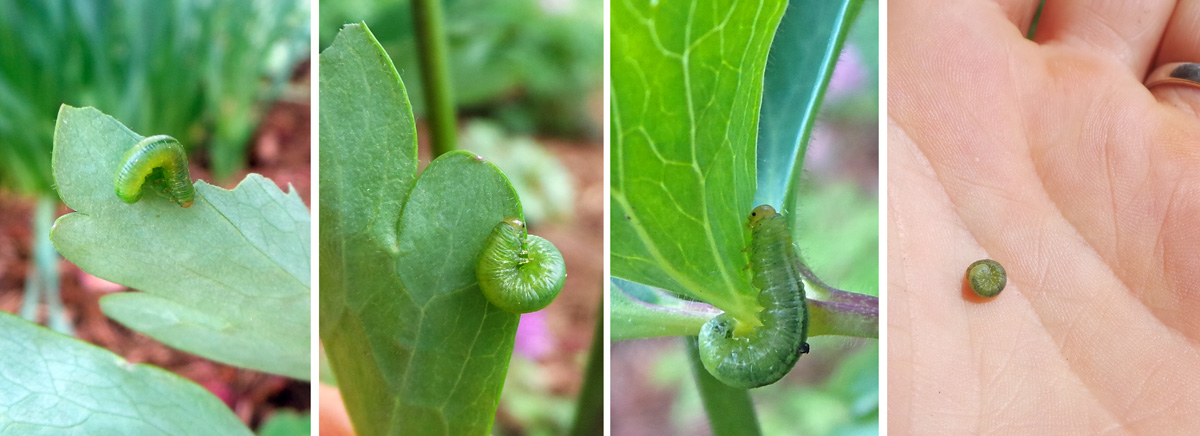
There are many species of sawflies, with most able to feed only on one type of plant. Other plants commonly attacked by sawflies include roses, pines and mountain ash, but the sawfly species that attack those plants are not the same as the one that feeds on columbine.
– Susan Mahr, University of Wisconsin – Madison





 Aster, Symphyotrichum spp.
Aster, Symphyotrichum spp. Fascinating Fasciation
Fascinating Fasciation Alternatives to Lawn: Groundcovers
Alternatives to Lawn: Groundcovers Marigolds
Marigolds


